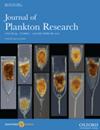Experimental analysis of development, lipid accumulation and gene expression in a high-latitude marine copepod
IF 2
3区 环境科学与生态学
Q2 MARINE & FRESHWATER BIOLOGY
引用次数: 0
Abstract
Abstract The high-latitude copepod Neocalanus flemingeri exploits the spring phytoplankton bloom to accumulate lipids for survival during food-limited periods and to fuel reproduction. At some point during development, lipid-accumulation ends and pre-adults molt into adults, descend to depth and enter a state of dormancy termed "diapause." How and when they determine to make this transition is still unresolved. According to one hypothesis, the trigger is their attaining a threshold amount of "lipid fullness." Alternatively, they might follow a genetic program, entering diapause within a narrow developmental window. To better understand the decision, a 5-week laboratory experiment was conducted to assess the effect of food quantity and type on lipid accumulation, biomass and gene expression in N. flemingeri copepodite stage CV. In fed individuals, the initial rate of lipid accumulation slowed by week 5, as a portion of CVs began to molt into adults. While changes in gene expression common to all fed individuals between weeks 1 and 3 were consistent with a developmental program, the duration of the CV stage was variable. Unfed individuals maintained lipid stores initially, suggesting physiological acclimatization to conserve energy. A comparison with gene expression profiles of field-collected individuals suggests similar responses to resources in the environment.高纬度海洋桡足动物发育、脂质积累和基因表达的实验分析
高纬度桡足动物新海螺(Neocalanus flemingeri)利用春季浮游植物繁殖来积累脂质,以便在食物有限的时期生存并为繁殖提供燃料。在发育过程中的某个时刻,脂质积累结束,前成虫蜕皮为成虫,下降到深处,进入一种称为“滞育”的休眠状态。他们如何以及何时决定进行这种转变仍未得到解决。根据一种假设,触发因素是他们达到了“脂质丰满”的阈值。或者,它们可能遵循遗传程序,在一个狭窄的发育窗口内进入滞育。为了更好地理解这一决定,我们进行了为期5周的室内实验,研究了食物数量和种类对蹼足桡足螨CV期脂肪积累、生物量和基因表达的影响。在喂食的个体中,脂质积累的初始速率在第5周减慢,因为一部分CVs开始蜕皮成虫。虽然在第1周至第3周期间,所有喂食个体的基因表达变化与发育计划一致,但CV阶段的持续时间是可变的。未喂食的个体最初保持了脂质储存,这表明生理适应是为了保存能量。与野外采集的个体基因表达谱的比较表明,对环境中的资源有类似的反应。
本文章由计算机程序翻译,如有差异,请以英文原文为准。
求助全文
约1分钟内获得全文
求助全文
来源期刊

Journal of Plankton Research
生物-海洋学
CiteScore
3.50
自引率
9.50%
发文量
65
审稿时长
1 months
期刊介绍:
Journal of Plankton Research publishes innovative papers that significantly advance the field of plankton research, and in particular, our understanding of plankton dynamics.
 求助内容:
求助内容: 应助结果提醒方式:
应助结果提醒方式:


